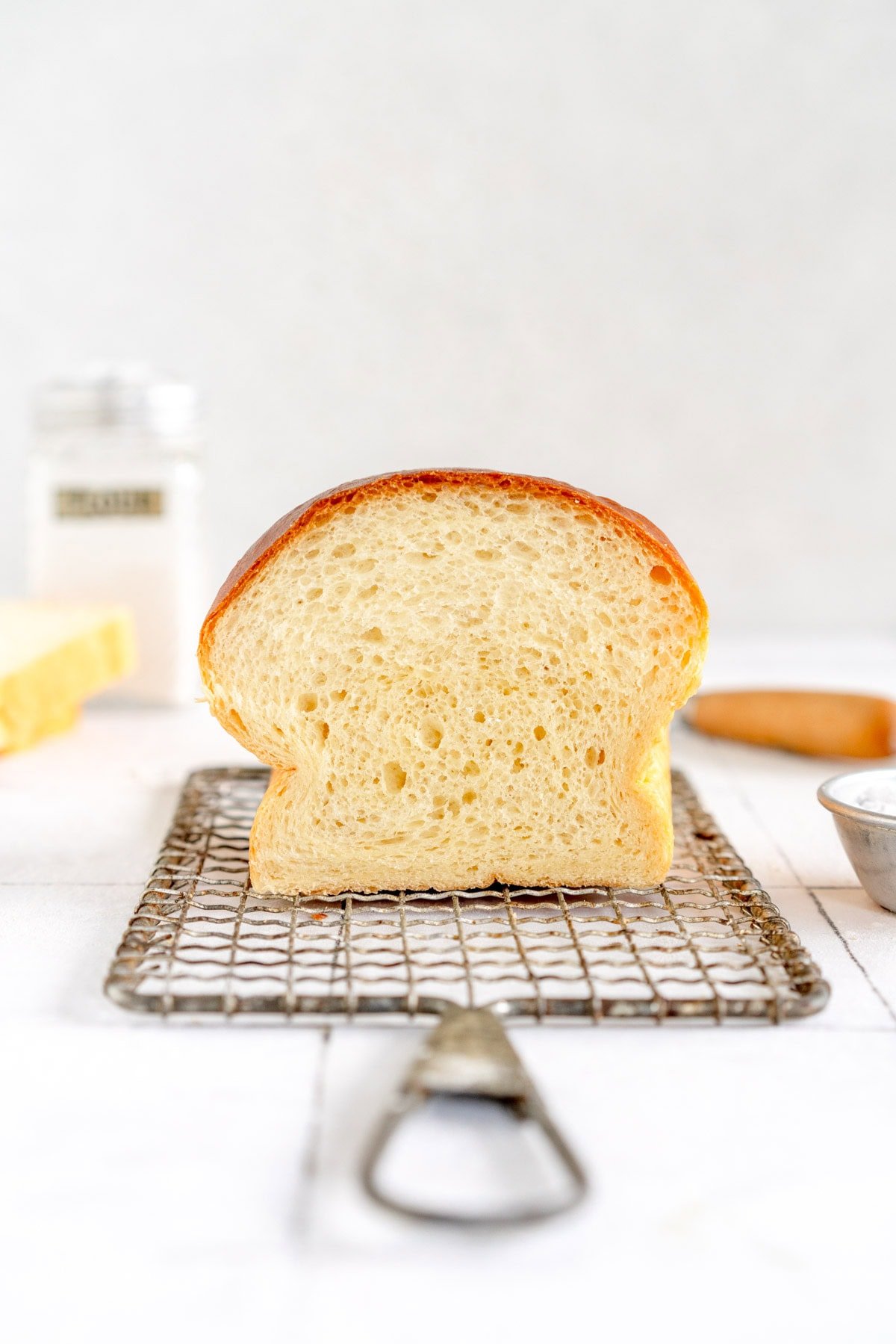Gentle and fluffy white bread recipe – made with a easy white bread dough, this simple bread recipe makes two good loaves of white bread. The recipe makes use of easy elements and provides a lightweight, comfortable bread that’s good for slicing. Observe my step-by-step recipe and complete information to take advantage of superb loaf of do-it-yourself bread.
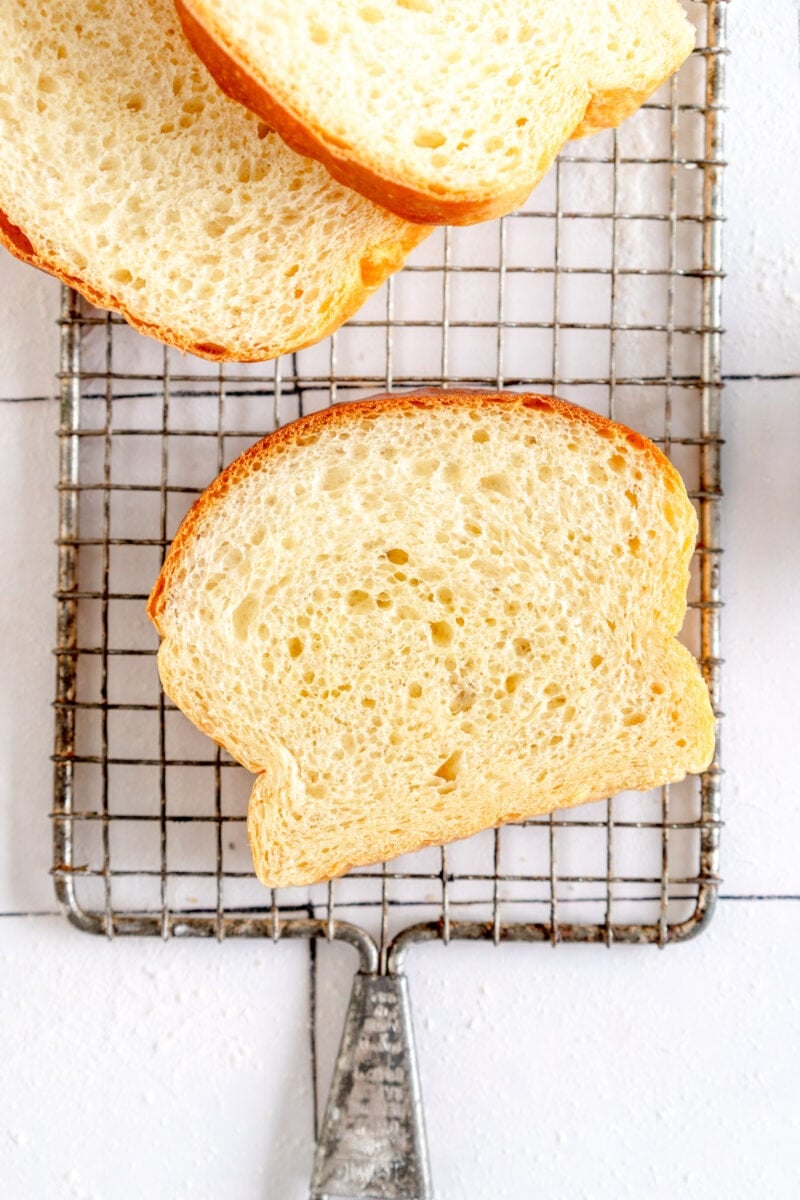
Hello hello! I’m simply popping in with this tremendous simple white bread recipe! This recipe makes two loaves of white bread, and makes use of my base white bread dough recipe. It’s tremendous simple to make, and is an effective way to be taught to bake bread in case you are simply getting began.
I like all the things about this bread recipe – it’s comfortable and fluffy, however the dough remains to be very easy to work with. The bread retains for a couple of days and makes essentially the most superb toast, and the leftovers take advantage of superb garlic bread. I typically bake one loaf after which pop the opposite one within the freezer for one more time.
I performed round with a number of variations of this recipe, so take a look at the submit for all my ideas and tips on the way to make one of the best white bread loaf!
Tremendous Easy White Bread Loaf
As a baking blogger, I’ve been posting every kind of bread recipes for years now, however realised I nonetheless do not have only a good outdated primary white bread recipe. That is one thing we eat quite a bit at our home, and so I figured I wanted to make a superb base dough that was tremendous versatile.
I needed one thing that wasn’t too fussy to make and used elements I already had in the home. We normally eat this recent, however it does take advantage of superb toast too – we frequently eat it with egg salad, or my Husband loves it toasted with Nutella.
It is only a tremendous easy, strong recipe for white bread – we find it irresistible quite a bit and I hope that you just do too.
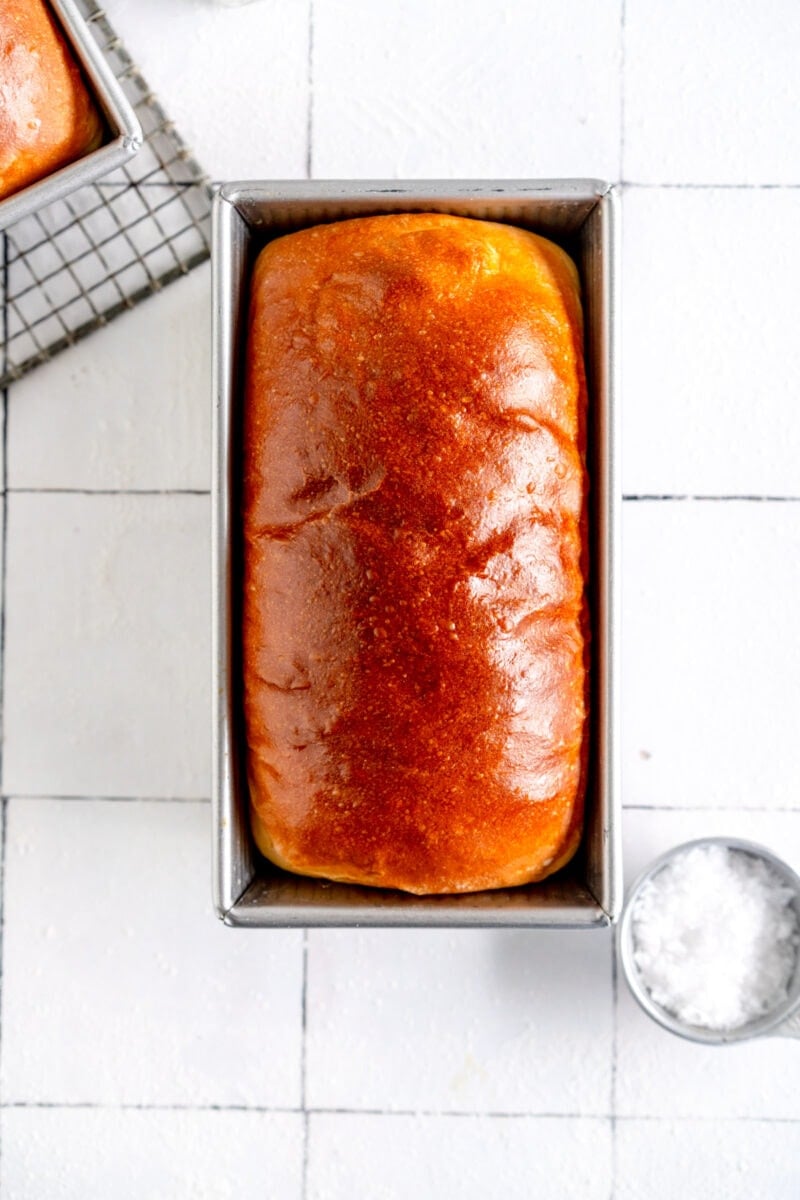

Two Good Loaves of Bread
This white bread recipe makes two loaves of bread – I typically throw one within the freezer or reward one. I determine that if you will go to the hassle to make your personal do-it-yourself bread, then you definitely would possibly as properly get two loaves out of it – it is not actually any additional effort.
I’ve two of the identical loaf pans that I exploit for this white bread loaf recipe, however you’ll be able to actually form it to suit as you want – alternatively the dough recipe is similar to the one which I exploit for my Parker Home Roll recipe, so you may divide the dough into two and form half right into a loaf and half into bread rolls to make use of for one thing else.
What’s the greatest loaf pan to make use of to make bread?
I choose to make this white bread recipe in a 1 lb loaf pan which is an 8.5″x4″ / 22cmx12cm pan. You need to use no matter dimension you’ve gotten, however for me this makes a pleasant sized loaf.
When you use a pan that could be a barely totally different dimension, then the bread might come out a bit of shorter – it is going to nonetheless be actually good, only a barely totally different form! I did attempt baking this multi function in a pullman pan and it acquired HUGE and nearly ate my oven rack, so I wish to attempt it in two smaller pullman pans and see the way it goes.
How do you retailer loaves of baked bread?
This bread is greatest on the day that it’s baked for consuming recent and for utilizing for issues like sandwiches, however the beauty of my white bread dough is that it makes bread that stays good and comfortable for days because of the great comfortable dough and the milk powder within the recipe.
You possibly can both retailer leftovers flippantly wrapped, or in an hermetic container at room temperature.
This will not be for everybody however I do not thoughts a barely crunchy crust, so I typically simply retailer the bread lower facet down on my chopping board and that creates sufficient of a seal that it stays good and recent.
You possibly can retailer this bread at room temperature for as much as 4 days – it will not be as recent as once you first made it, however it is going to nonetheless make nice toast!
Can Bread be frozen?
Sure! This White bread recipe freezes tremendous properly – simply wrap it in plastic wrap properly after which pop right into a ziploc bag after which freeze. It can hold, properly wrapped, for as much as 3 months – when you find yourself prepared to make use of it, defrost at room temperature. I choose to make use of bread that has been beforehand frozen for toast, or for making garlic bread.
You can even pre slice the bread earlier than you freeze it if you wish to hold it within the freezer to take away items to slice – I prefer to retailer slices in a ziploc bag.
What’s one of the simplest ways to refresh outdated bread?
I choose to toast outdated bread to provide it a bit extra life, nevertheless you can too simply rapidly zap within the microwave to refresh the bread barely.
If you wish to refresh an entire loaf, you’ll be able to pop it within the oven at 350°f / 180°c till it’s warmed by means of – simply regulate the crust.


The way to form a loaf of bread for a loaf pan
This may positively take a little bit of observe, however when you get it sorted, you can be high-quality. Do not be afraid of dough shaping – worst case situation your dough comes out a bit wonky and what to repair subsequent time.
This works for any pan dimension – simply make the preliminary rectangle about the identical size because the pan is. Keep in mind that it’s okay for the dough to not be so long as the pan is once you simply put it in after shaping – you’ll be able to see by the photographs that it fills the pan.
Here’s a step-by-step information on the way to form dough right into a loaf pan. That is simply how I do it. In case you have a method to form a loaf of bread that works higher for you, then go for it and use that as a substitute!
Step One: DIVIDE. My white bread dough recipe makes sufficient for 2 loaves of white bread (or one loaf of white bread and a small batch of one thing else). You wish to work with one piece of dough at a time, so divide the dough into two items.
That is the place it may be useful to know the load of the blending bowl that you just had been rising the bread dough in, with the intention to weigh the entire thing and subtract the load of the bowl to work out how large every bit must be. My recipe makes 850g dough, so that you wish to divide the dough into two items, every weighing 425g every. Keep in mind you probably have adjusted any elements or your eggs are heavier or lighter than mine and so forth this will differ however simply be sure that they’re roughly the fitting dimension.
Divide the dough into two items, after which form every into a good ball utilizing a bench scraper. Use a flippantly floured floor if that you must however attempt to not use an excessive amount of extra flour so it would not get rolled up within the dough.
Relaxation the dough balls underneath a clear tea towel or flip a bowl the other way up on them and depart for 10 minutes simply to let the gluten chill out a bit of.
Step Two: FLATTEN. Work with one piece of dough at a time. Evenly flour the dough ball, after which flip it over. Dough balls have two sides – the ‘good’ facet after which the butt of the dough ball, which won’t be as clean from shaping it right into a ball. You need the ‘good’ facet on the underside as that is going to be the outward going through facet and also you need the sleek facet out.
If there are any large bubbles within the dough, pop them (see that one on the left of the dough that I ought to have popped with my fingers)
Flatten the dough right into a rectangle utilizing your fingers – you need it to be concerning the width that your bread pan is lengthy.
Step Three: FOLD. Fold the sides in – this offers you a pleasant clear finish on the log of dough, reasonably than having to take care of little dough tails it’s a must to tuck in afterward. I prefer to fold the perimeters in just a bit bit and be sure that they’re properly sealed with my fingers.
Step 4: ROLL. That is the place you form the precise log of dough. I have to get one other picture, however you’ll be able to both work towards you or away from you – no matter feels greatest. I prefer to work away from myself. You’re going to roll the dough up into a pleasant tight sausage formed package deal right here, and also you wish to make it good and tight and be sure that there’s no air trapped within the loaf in order that you do not get bizarre bubbles (however it’s not the top of the world in case you do). The rolling stage is kind of a two step – you do an preliminary little roll to get began and be sure that it’s properly sealed, then roll the entire thing up.
Fold the underside fringe of the dough up a couple of third, and press it down along with your fingertips to just be sure you have a superb seal. Then proceed rolling up the log of dough till you’ve gotten a pleasant tight roll. Keep in mind the dough goes to rise once more right here so do not be too fearful about knocking out air.
Use the countertop to tug the log of dough towards you to create pressure beneath to assist seal the seam and to assist clean off the highest of the dough. Tuck in any unfastened ends. The dough will look a bit shorter than the size of the pan.
Repeat with the opposite piece of dough. They’re now able to rise in a heat spot till you bake them – for me this normally takes about an hour however is usually a little kind of time relying on the climate.
The way to rise white bread loaves.
The rise on bread dough is a essential step, significantly the second rise. You wish to rise the dough in order that the yeast nonetheless has sufficient power in it to work within the oven to provide you a pleasant, mild, fluffy loaf of white bread.
Evenly cowl the loaf pans with plastic wrap – don’t make it too tight as you do not need the dough to stand up and get trapped within the plastic wrap. For a 1lb loaf pan which is what I used, a correctly risen loaf will simply peek over the sting of the pan, as you’ll be able to see within the picture under – this one was completely risen and prepared to enter the oven.
How lengthy does the second rise take?
This actually is determined by how heat your climate / kitchen is. Whether it is hotter, this will go a bit of faster, because the dough will rise sooner and you’re additionally beginning the second rise with hotter dough. Whereas if it’s a bit cooler, then it could take a bit of longer.
The rise time is absolutely depending on this, which is why it is very important regulate your dough, and never simply go by the point within the recipe. I exploit a dough proofer once I make bread now in order that I may give you tremendous correct rising instances, and I’ve it set to 22°c / 71°f.
At this temperature, the second rise on my bread loaves takes about an hour. I begin to test them on the 50 minute mark to see how they’re going. Keep in mind that ovens can take some time to heat up correctly too, so intention to preheat your oven about 20 minutes earlier than you assume the loaves will likely be prepared to enter the oven.
Whether it is chilly in your kitchen, you are able to do a couple of issues to make a pleasant heat spot to proof your bread – both within the oven with a bowl of heat water or boiling water within the oven alongside or beneath it to make it good and heat and steamy, or you’ll be able to place it within the microwave alongside a mug of boiling water to do the identical factor. Simply be sure you do NOT PREHEAT YOUR OVEN with bread dough in there. I’ve executed it and it’s so, so unhappy.
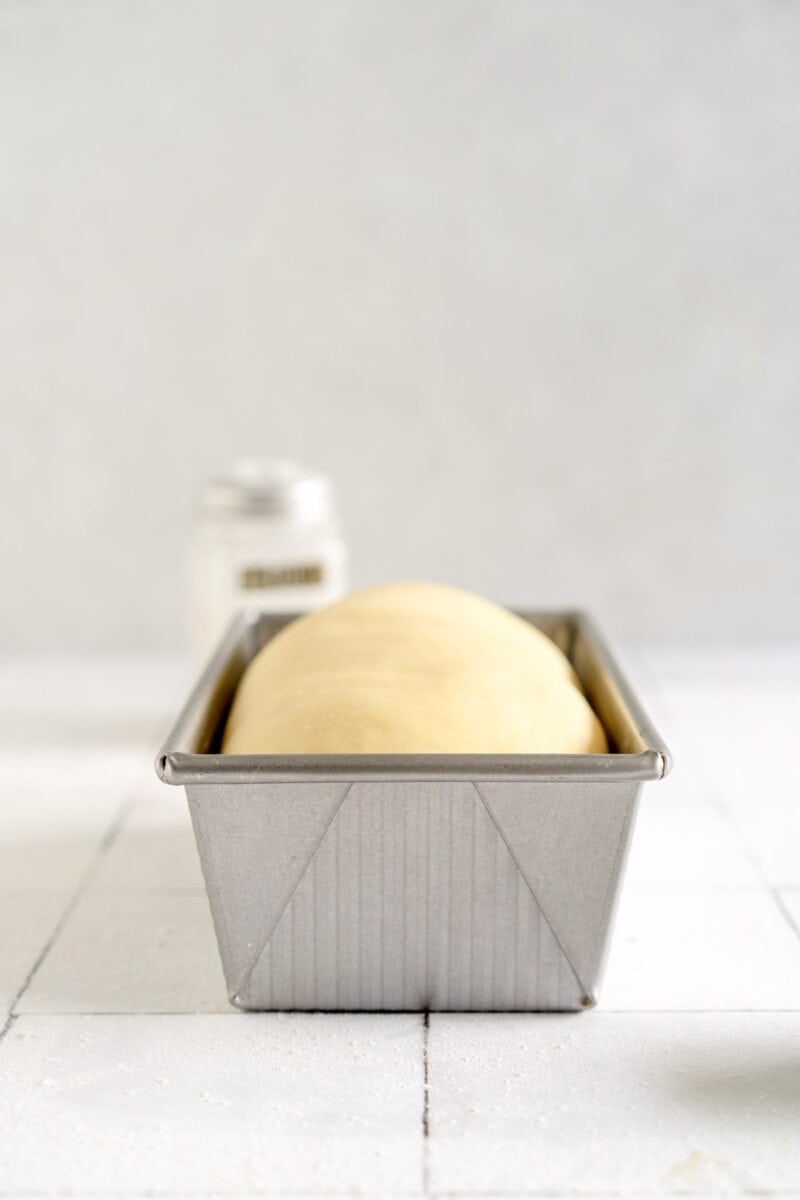

The way to inform when dough is risen
One of the best ways to inform in case your dough is correctly risen is to provide it a finger poke take a look at. After getting made a couple of loaves / labored with bread a bit, you get higher at telling when it’s prepared to enter the oven – this step may be troublesome to be taught however you’ll get there!
Evenly flour your finger, and provides the dough a mild poke. If it’s not able to bake but, the dough will spring again fully. Whether it is risen adequately, then your finger will depart an indentation that slowly springs again.
How do I do know if my bread is overproofed?
Overproofed bread occurs to one of the best of us, and it’s unhappy when it occurs! What occurs when bread overproofs is that the yeast mainly runs out of meals earlier than the bread will get into the oven, so it doesn’t have any extra power to provide, and the bread will collapse.
You possibly can see within the photographs under – the loaf on the left is overproofed. On this case it was from testing the second rise within the fridge, however it may possibly additionally occur if the dough is left too lengthy at room temperature to rise.
While you do the finger poke take a look at with over proofed dough it is going to collapse underneath your fingertips, after which it won’t rise within the oven very a lot, and be flat and a bit extra dense.
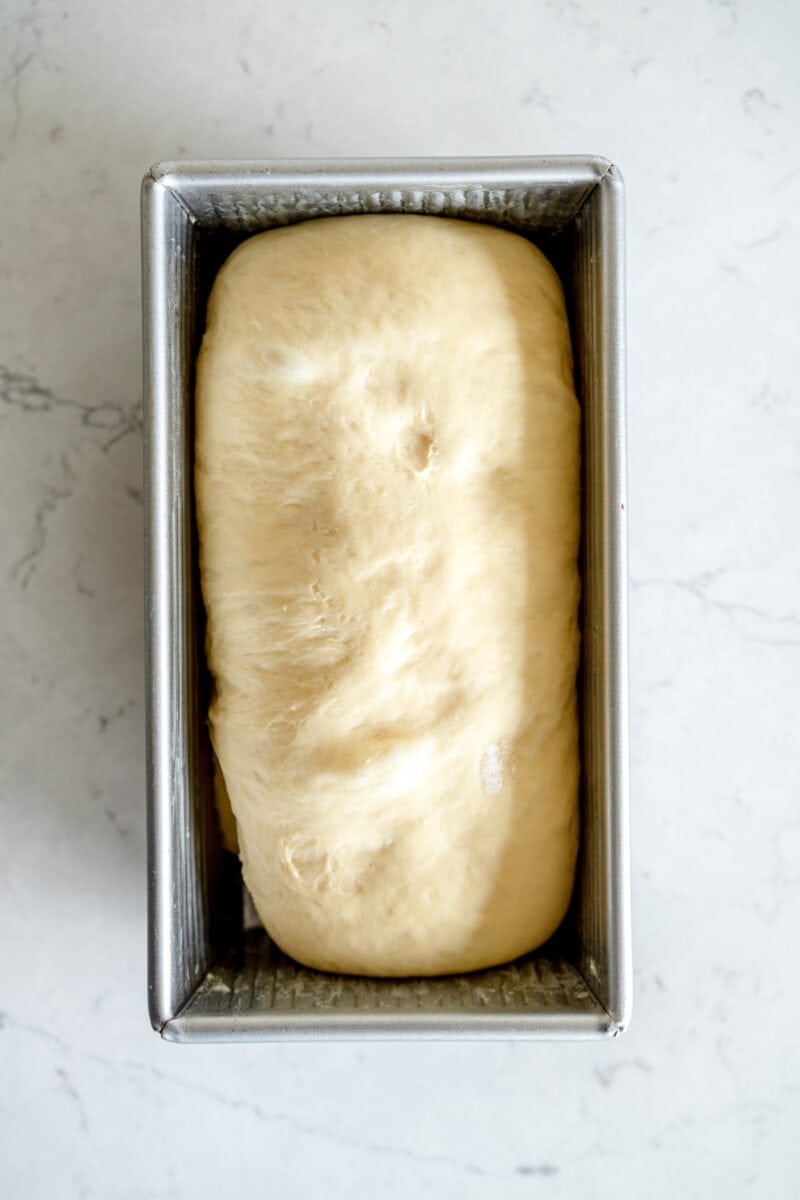

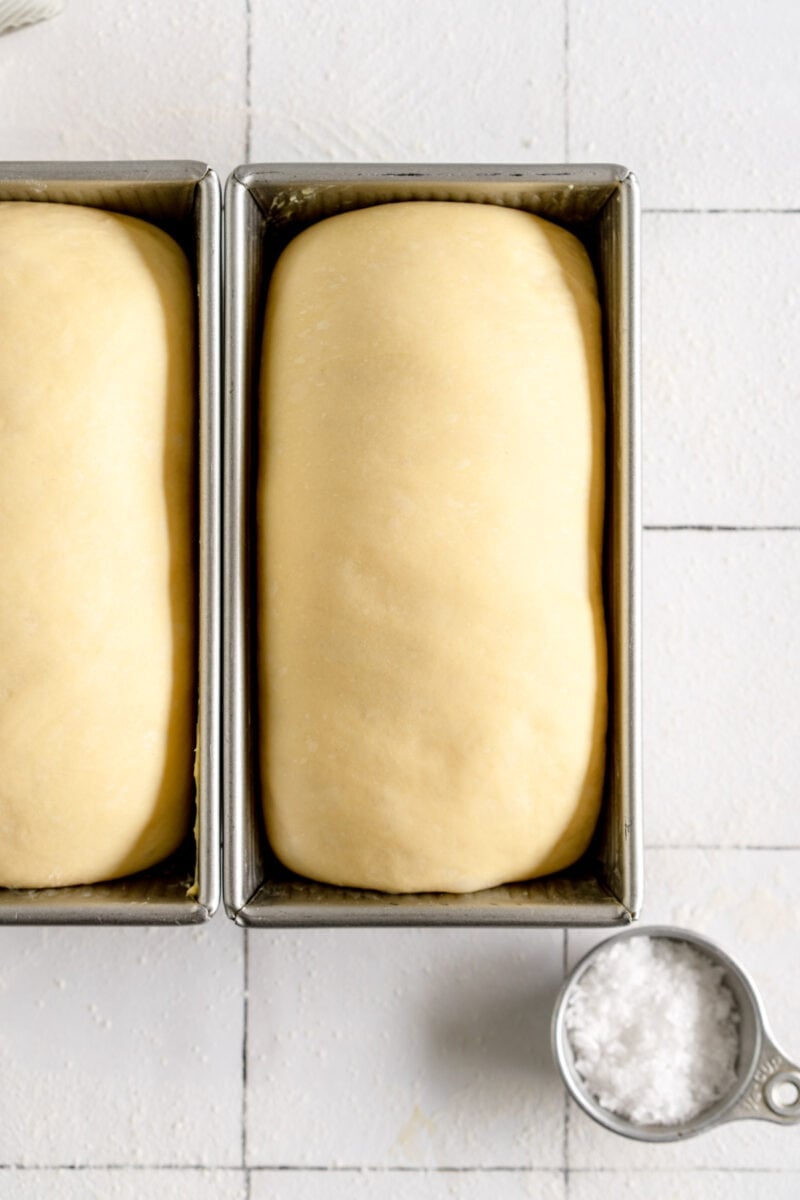

What occurs if I over proof my dough?
Keep in mind it’s not the top of the world and it occurs to everybody. The bread will nonetheless be edible, it’d simply not have the nicest texture. If I overproof bread I normally flip it into garlic bread or slice and toast to have alongside soup.
In case you have over proofed the dough on the first rise, it’s typically potential to only deflate the dough and form the loaves after which give them a second rise and see the way it goes. Nevertheless in case you overproof on the second rise, there is not as a lot you are able to do and you’ll simply have to bake it and have barely dense bread. It can nonetheless style good and what to search for subsequent time!
You possibly can see within the photos under the distinction between an overproofed loaf (on the left) and a correctly proofed on the fitting – these had been made with the same amount of dough, one was mild and fluffy, and the opposite tremendous dense.
Can I do the second rise within the fridge?
I get requested this on a regular basis about if individuals can do the second rise within the fridge then bake, and I do not suggest it for a couple of causes. Nevertheless, I examined it simply so I might actually present you the way I do not actually suggest it. An extended gradual rise works greatest for bulk fermentation (the place the dough is in a single lump), reasonably than for the second rise.
It’s far too simple to over proof dough on the second rise within the fridge, which is why I don’t suggest it. Here’s a breakdown of why:
- Method too simple to over proof. As I used to be saying, a chilly rise within the fridge is simply too lengthy for this recipe. It really works nice with a sourdough recipe, however for this recipe made with industrial yeast, it doesn’t work.
- Finally ends up taking even longer to make. I do know that working forward of time is what lots of people choose, however in case you do a room temperature first rise after which attempt to do the second rise within the fridge, you then nonetheless should convey the loaf out and depart it to return to room temperature to be alright to bake, and this will take 2-3 hours, which is similar period of time that it takes to rise dough that has had a chilly first rise.
I do nevertheless suggest doing the primary rise within the fridge if you want, then shaping the dough and doing the second rise at room temperature. Keep in mind in case you begin with chilly dough it is going to nonetheless take about 2 – 2 ½ hours to rise relying on the temperature of your kitchen, however your danger of overproofing the dough is much much less. If you wish to make this dough forward of time, do a chilly rise first and a room temperature rise second. I break this down absolutely in my white bread dough submit.
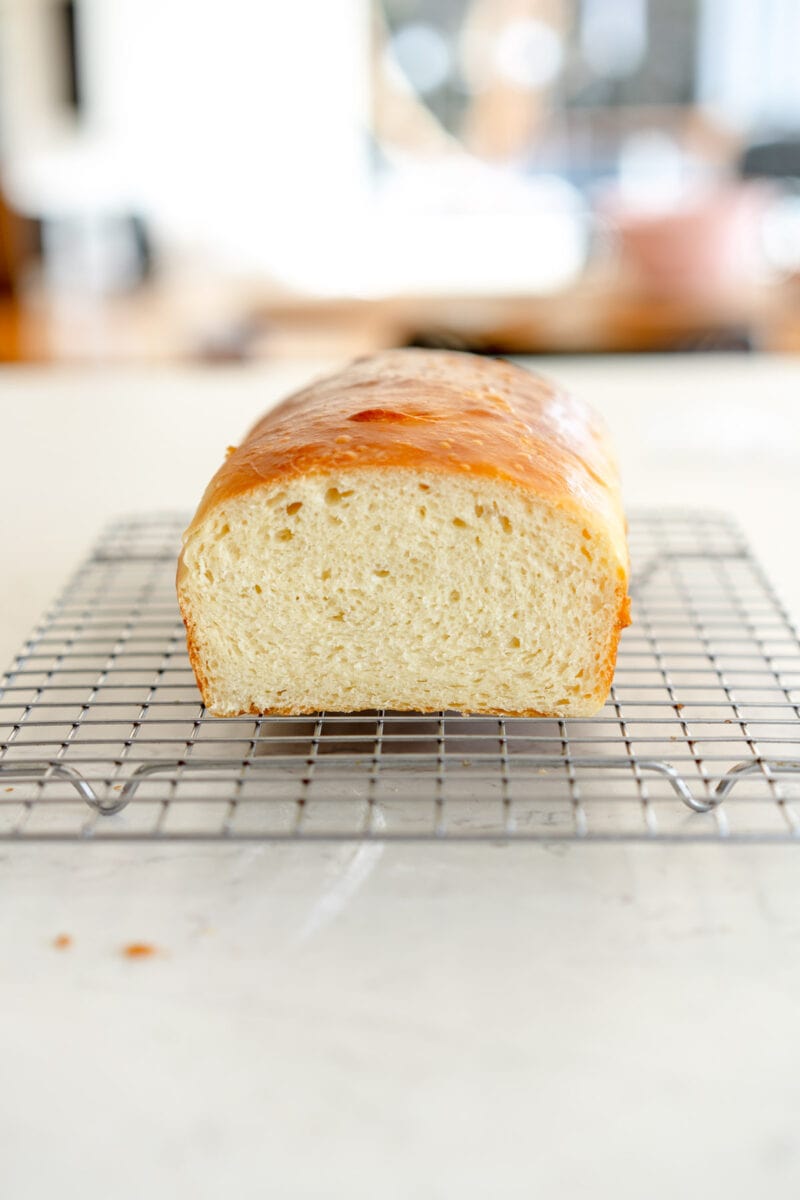

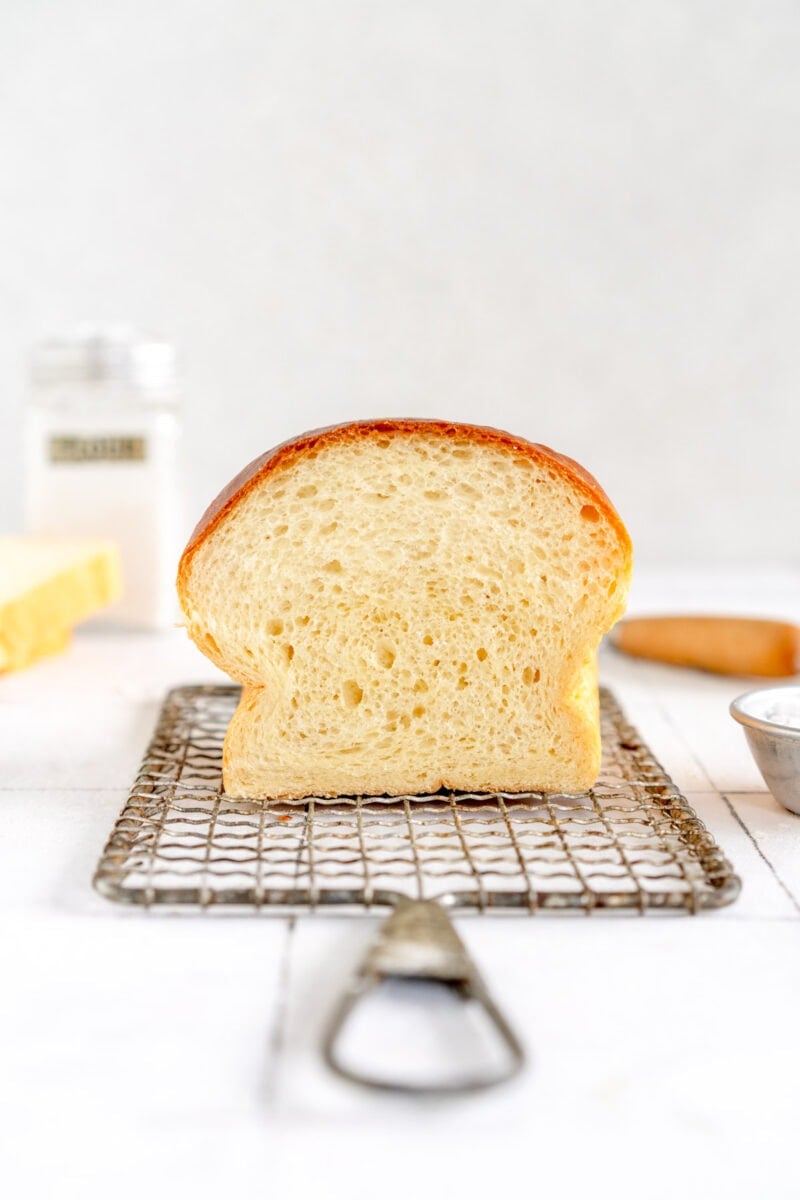

The way to inform when bread is correctly baked.
This white bread recipe takes about 25 minutes within the oven to bake. I prefer to bake mine till it’s good and golden brown, however if you would like yours a bit of extra on the pale facet, you’ll be able to cowl the pan with foil partway by means of the baking course of.
There are a couple of methods to be sure that your bread is completely baked by means of earlier than eradicating it from the oven –
- The faucet take a look at – give the bread a bit of faucet. It ought to sound barely hole.
- Rise – The bread will likely be evenly risen within the pan. This loaf bakes up pretty even on the highest, so it must be properly risen within the pan and can bounce again in case you give it a bit of poke. It can even be pulling away from the sides barely.
- Temperature. I typically use this technique when baking bread simply to double test my inside temperature of my bread. When you measure bread with a digital thermometer, it is going to register at 190°f / 88°c when baked. That is an particularly good method to test for doneness in case you are new to baking bread – that is the candy spot the place the bread is baked however will not be too dry.
Just remember to use these cues when testing if bread is baked. In case your oven is working scorching, it may possibly make the outside of the loaf look executed earlier than the within is absolutely baked.
As a result of the dough is tremendous comfortable, the sides of the loaf would possibly collapse in a tiny bit – you’ll be able to see this in photographs. That is simply from a stunning comfortable dough!
Do I’ve to make use of egg wash?
I like to complete my white bread loaves with egg wash earlier than they go into the oven. This helps to provide them a pleasant golden brown end. Nevertheless if you do not have a spare egg readily available, you should use milk or cream to brush on the bread – it simply will not be as deeply golden brown!
I made this bread in New Zealand, and we’ve tremendous yellow butter, eggs, and so forth. So once I bake, my bread comes out way more golden brown and yellow trying on the within than if I had baked it in a rustic which did not have the identical high quality of elements. If yours seems rather less yellow or golden than mine, that’s all good!


Regularly Requested Questions
What instruments and gear do you utilize?
You’ll find a full checklist of the instruments and gear I exploit on my merchandise web page
Which pan did you utilize?
I baked this bread in a 1lb loaf pan – you should use no matter you’ve gotten, however keep in mind that the size of the loaf might differ barely in case you accomplish that.
For extra do-it-yourself bread recipes, take a look at:
❤️ Made this recipe and find it irresistible? ❤️
I’d LOVE so that you can depart me a evaluate and star score under to let me understand how you appreciated it! Additionally, please be sure to tag me on Instagram!
Solutions to your baking questions
Over time, a lot of you’ve gotten requested me questions on:
I’ve curated and answered all of them in your simple reference on this steadily requested questions submit!
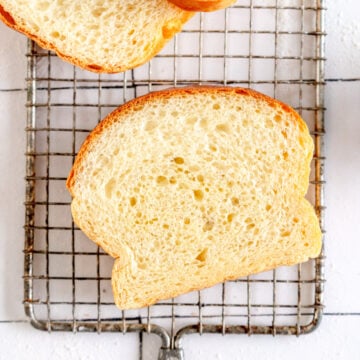

Gentle and Fluffy White Bread Loaf
Prep Time: 1 hour
Cook dinner Time: half-hour
Whole Time: 4 hours
Yield: 2 loaves
Class: bread
Methodology: baking
Delicacies: american
Description
Gentle and fluffy white bread recipe – made with a easy white bread dough, this simple bread recipe makes two good loaves of white bread. The recipe makes use of easy elements and provides a lightweight, comfortable bread that’s good for slicing. Observe my step-by-step recipe to take advantage of superb loaf of do-it-yourself bread.
Bread Dough
- One batch of white bread dough, risen and able to use (see dough submit for rising choices)
To End
- Softened butter for greasing the loaf pans
- Egg wash – one egg whisked with 1 Tbsp water
Directions
- Begin with risen white bread dough. In case you have chosen to do a chilly first rise, you will have to depart the dough out at room temperature for about half-hour to permit it to melt barely in order that it’s simpler to work with.
- Grease two 1 lb loaf pans (8.5 x 4.5″ / 22cm x 12.5cm) with softened butter.
- End up the risen dough onto a flippantly floured, clear work floor. Divide it into two even items (the dough makes about 850g of dough so divide it into two 425g items).
- Form every bit right into a ball utilizing a bench scraper and utilizing the counter to create pressure. Cowl the items of bread dough with a clear tea towel and depart to relaxation for about 10 minutes.
- Working with one piece of dough at a time, form the dough right into a loaf form – flip the dough over so the ‘good’ facet is going through down.
- Flatten the dough out utilizing your fingers right into a rectangle concerning the width that your tin is lengthy. For a 1lb loaf pan, that is about 20cm x 15cm (8×6″). Fold over a bit of of the brief edges to type a tough sq. form (this doesn’t should be precise). This helps to provide you good clear ends in your bread.
- Fold the highest third of the dough down, and press along with your fingers in order that it sticks to the dough beneath – you wish to type a mild seal. Roll the remainder of the dough down towards you as tightly as you’ll be able to. Pull the sausage of bread towards the counter to assist seal the seam and be sure that the ends are properly tucked in.
- Place the dough into the loaf pan fastidiously, seam facet down. It won’t fully contact the ends of the pan.
- Repeat the shaping course of with the second piece of dough to type a second loaf.
- Cowl the pans with plastic wrap or a clear tea towel and place in a heat spot till the dough has doubled in dimension and is nearing the highest fringe of the pan, about one hour relying on the temperature of your kitchen. To test the rise on the dough, flippantly press it with a floured finger – whether it is absolutely risen it is going to depart an indentation that slowly springs again. In case you have began with a chilly dough, this step will take 2-3 hours as that you must account for the dough warming up.
- Whereas the loaves are rising, preheat the oven to 180°c / 350°f. Prepare a rack in the course of the oven.
- When the loaves are risen, brush the floor of the dough with egg wash.
- Bake the white bread loaves for 25 to half-hour, till deeply golden brown. If you wish to test the inner temperature, a completely baked loaf ought to register at 190°f / 88°c when probed with a digital thermometer.
- Take away the loaves from the oven and place on a cooling rack. Go away to chill within the pans for 10-Quarter-hour then prove of the pans and switch to a wire rack to chill fully.
- Slice when cool. Retailer leftovers in an hermetic container at room temperature for as much as 4 days. Finest eaten recent on the day it’s made, nevertheless leftovers are superb both barely warmed up, or flippantly toasted.
Notes
A barely bigger loaf pan will work too – the loaf may bake up barely shorter. When you solely have one loaf pan you’ll be able to form the opposite half of the dough into parker home rolls or rolls of your alternative.
